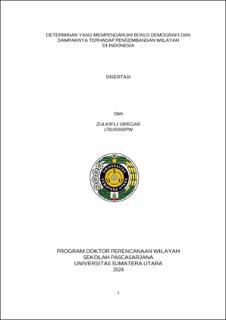| dc.description.abstract | Demographic bonus is a population phenomenon where the productive age population is more than the non-productive population. This phenomenon is a moment for a region to develop its territory. The purpose of this study was to analyze the effect of population growth on the demographic bonus in Indonesia, analyze the effect of life expectancy on the demographic bonus in Indonesia, analyze the effect of the contraceptive prevalence rate on the demographic bonus in Indonesia, analyze the effect school-age population on the demographic bonus in Indonesia, analyze the effect of population growth on regional development in Indonesia, analyze the effect of life expectancy on regional development in Indonesia, analyze the effect of the contraceptive prevalence rate on regional development in Indonesia, analyze the effect of the school-age population on regional development in Indonesia, analyzing the effect of population growth, life expectancy, contraceptive prevalence rate, school-age population on regional development mediated by demographic bonuses fi in Indonesia.
Research was carried out in the Indonesian region regarding the determinants that affect the demographic bonus and its impact on the development of the Indonesian region. The analytical tool used in this study is structural equation model (SEM) analysis accompanied by Partial Least Square (PLS) analysis. The results showed that there was a positive and significant effect of population growth on the demographic bonus in Indonesia. There is a negative and significant effect of life expectancy on the demographic bonus in Indonesia. There is a negative and significant effect of the contraceptive prevalence rate (CPR) on the demographic bonus in Indonesia. There is a positive and significant effect of the school-age population on the demographic bonus in Indonesia. There is a positive and significant effect population growth on regional development in Indonesia. There is a positive and significant effect of life expectancy on regional development in Indonesia. There is a negative and significant effect of the contraceptive prevalence rate (CPR) on regional development in Indonesia. There is a positive and significant effect of the school-age population on regional development in Indonesia. There is a negative and significant effect of demographic bonus on regional development in Indonesia. The demographic bonus cannot mediate the effect between population growth and regional development in Indonesia. living with regional development in Indonesia. Demographic bonuses cannot mediate the effect between the contraceptive prevalence rate (CPR) and regional development in Indonesia. Demographic bonuses can mediate the effect between school-age residents and regional development in Indonesia. | en_US |


